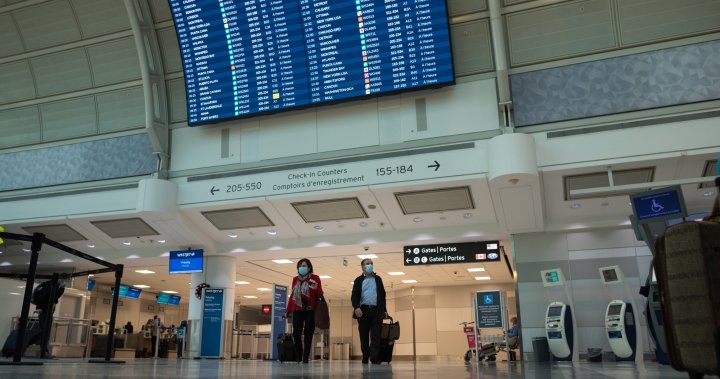On a cool day in May at the Vancouver airport last year, Heather Walkus found herself stuck on the curb without assistance for nearly an hour.
Eventually Walkus, who is blind and living with multiple sclerosis, was guided to the Air Canada check-in counter and escorted to her gate, but her flight to Penticton, B.C., was delayed.
“I spent four hours alone in a wheelchair, blind, without anybody checking on me,” she said. “I couldn’t go to the bathroom. I couldn’t eat. I couldn’t find anybody to help me.
“Then they expected me to be able to get up out of the chair and climb up stairs onto my flight. It was ridiculous,” said Walkus, who chairs the Council of Canadians with Disabilities.
“It’s like I was parked luggage,” she said. You’re just dumped and left.”
Walkus is among the accessibility advocates speaking out about unreliable assistance in air travel, pointing to regulatory gaps and scattershot enforcement that can leave travellers with disabilities injured, stranded or demeaned.

Community leaders describe mangled mobility aids, seemingly untrained staff and a check-in and boarding process akin to a slow-motion relay that shuttles passengers from one point to another, who sometimes wait hours unassisted.
The criticism comes after Air Canada pledged to roll out new measures that improve the experience for hundreds of thousands of travellers living with a disability.
In Ottawa, Transport Minister Pablo Rodriguez summoned Air Canada CEO Michael Rousseau for a sit-down Thursday following reports of passenger mistreatment, including an incident where a man with spastic cerebral palsy was forced to drag himself off of an airplane due to a lack of assistance.
Yet the problems go beyond a single airline, as “gaping holes” in the Accessible Canada Act allow problems to persist in areas ranging from consultation to assistance protocols, Walkus said — despite a regulatory overhaul in 2020 brought on by that legislation.
She cited the example of a rule requiring federally regulated companies to be involved in developing policies, programs and services — a “regulation you could drive a truck through.”
“You could send the administrator down to Tim Hortons and talk to someone in a wheelchair and you’ve consulted with the disability community. It’s a check-off,” she said. The group she heads was not contacted by Air Canada on its new accessibility blueprint, she added.
Francine Leduc, president of a Quebec-based group of accessibility advocates known as RAPLIQ, said existing rules aren’t so much the problem. Equal protection under the law regardless of “sex, age or mental or physical disability” has been enshrined in the Charter of Rights and Freedoms since that provision took effect in 1985, with stacks of legislation and regulations to flesh it out since.
The issue often boils down to poor training, she said. Leduc, who lives with mitochondrial myopathy, which causes prominent muscle problems, recalled on a recent trip how two flight attendants tried to haul her out of her chair rather than use a lift.
“One took my left arm and the other my right arm and they’re pulling me,” she said. “Imagine taking somebody like that, dealing with a handicapped person who has no strength, nothing.”
_ONLINE_848x480_1558274627956.jpg?w=1040&quality=70&strip=all)
On another Air Canada flight to Florida from Montreal with five friends — four used wheelchairs — the staff lost track of the documentation they’d submitted relating to their mobility aids before boarding. In Fort Lauderdale the next morning, they realized their scooters had failed to charge because staff had shut down the batteries without informing them — a fact they only figured out thanks to an engineer they managed to track down near the hotel.
“We can’t go anywhere without our wheelchairs. It’s our legs,” Leduc said.
Service for the hundreds of thousands of passengers who fly in Canada each year isn’t always terrible. It’s the lack of consistency — and the angst that comes with every trip as a result — that many find so frustrating.
“I have gotten everything from people who know what they’re doing to people who obviously had no training or, if they were given training, they don’t remember it. I have to teach them how to guide a blind person,” said David Lepofsky, visiting research professor of disability rights at Western University’s law faculty.
Statistics Canada found that 63 per cent of the 2.2 million people with disabilities who used federally regulated transportation in 2019 and 2020 faced a barrier.
© 2023 The Canadian Press




